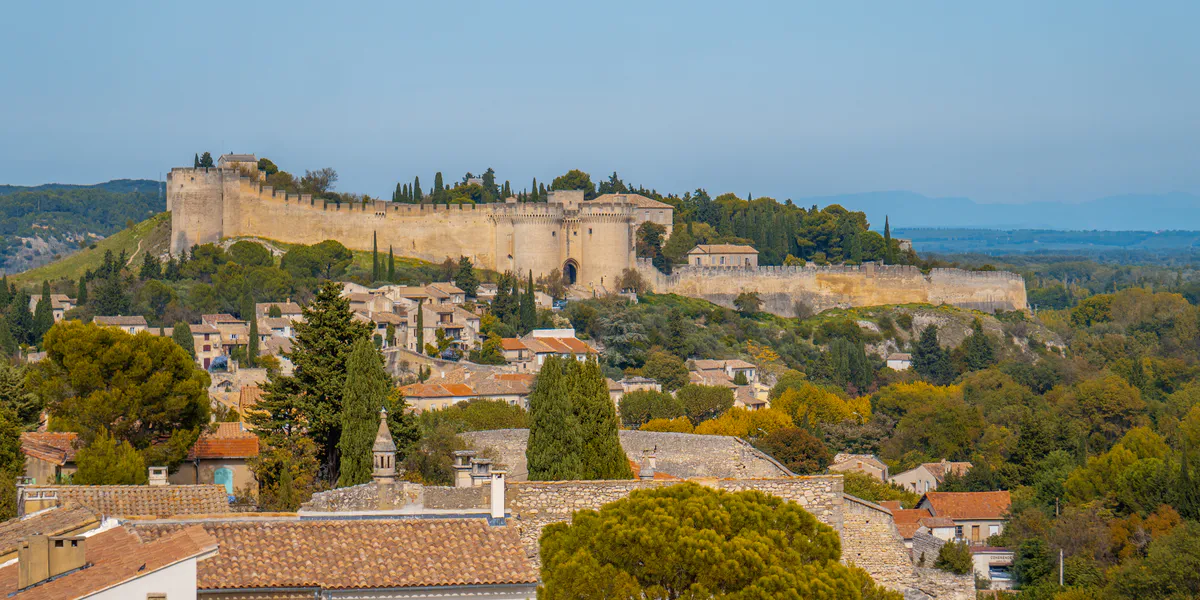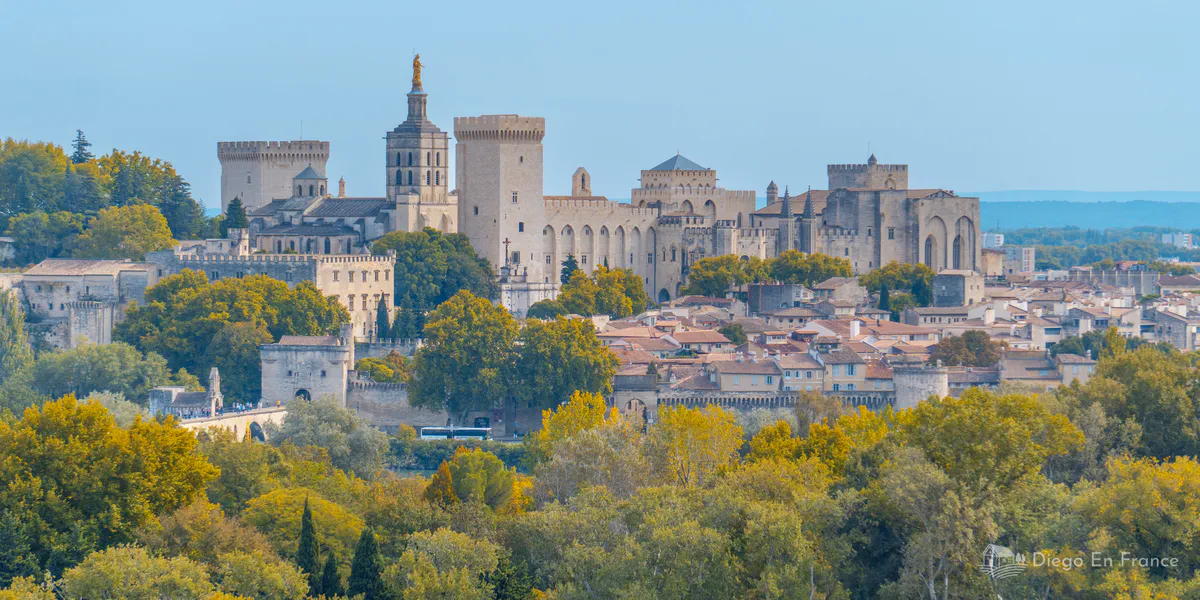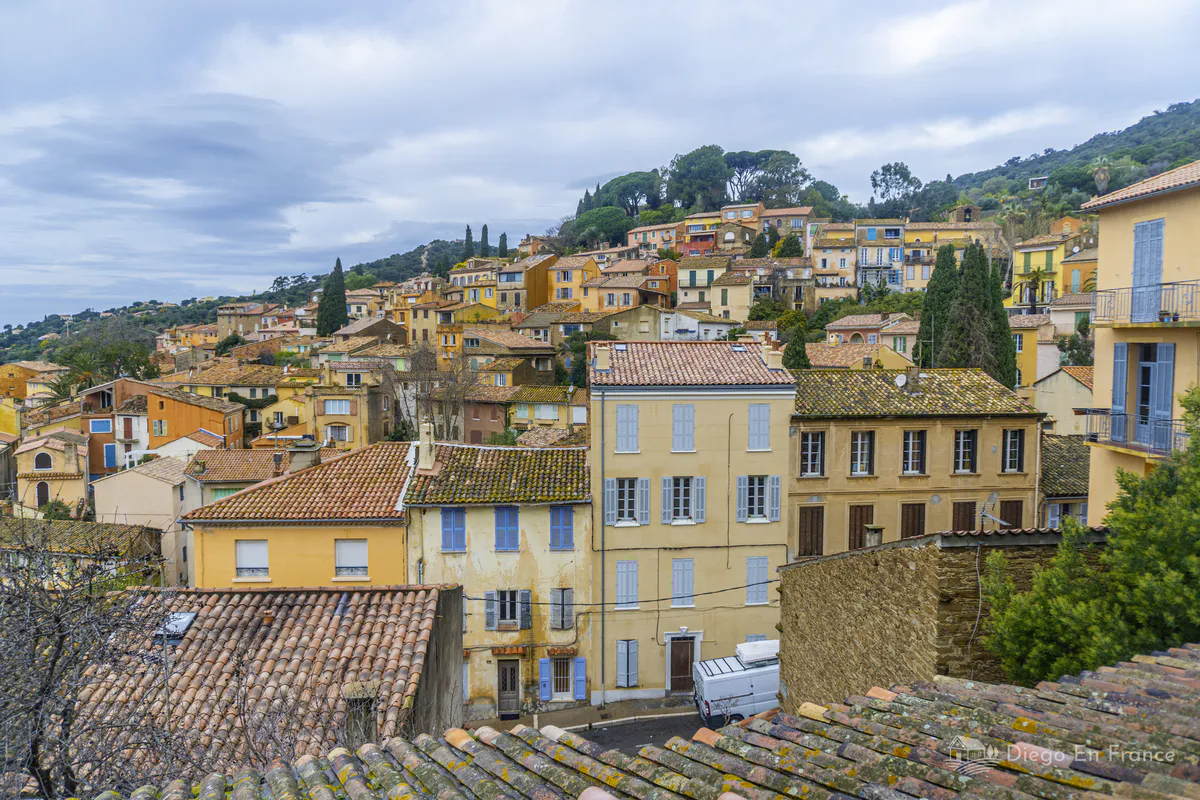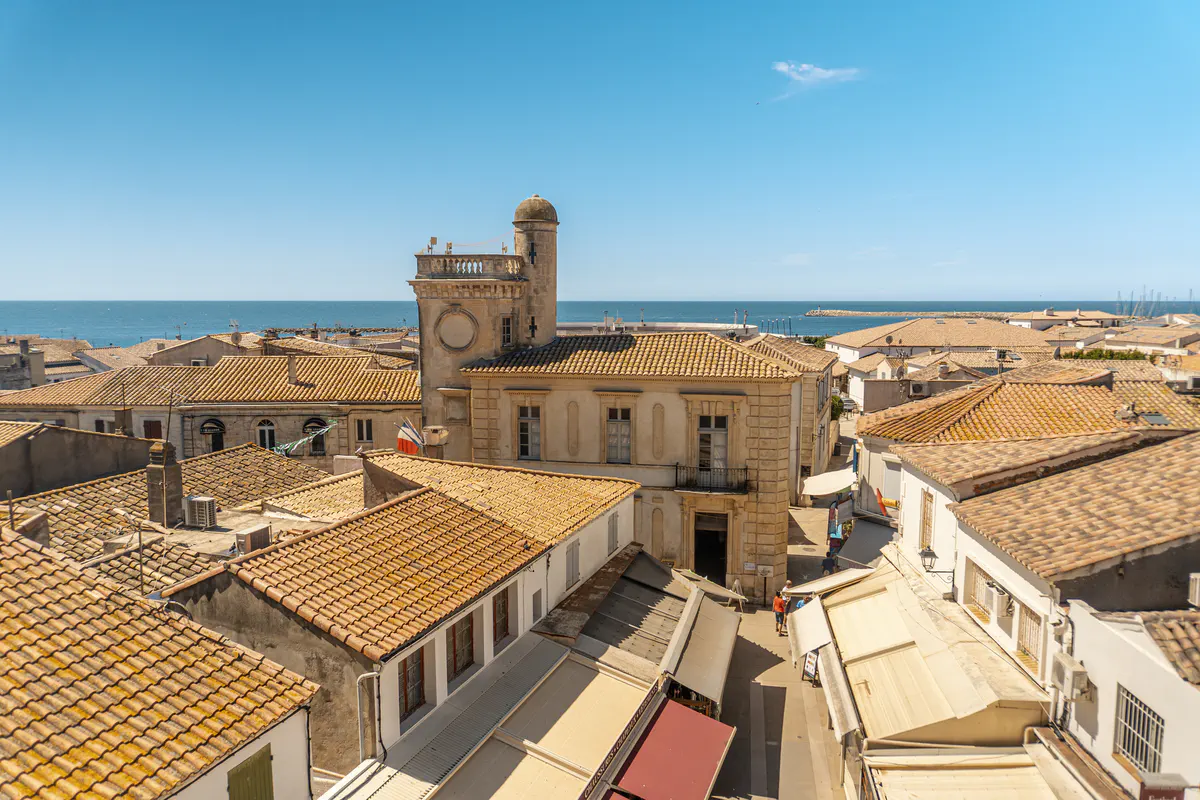On diegoenfrance.com, I share my favorite places in France — and Villeneuve-lès-Avignon is one of them: a medieval gem perfect for those who love authentic, family-friendly travel.
What to see and do in Villeneuve-lès-Avignon
If you’re looking for a place filled with history, art, and tranquility just across from Avignon, you’ll fall in love with Villeneuve-lès-Avignon. This medieval village in the south of France blends impressive monuments, unforgettable views, and a Provençal atmosphere — perfect for an authentic, cultural, and family-friendly escape.
In this article, you’ll find:
- The best places to see and experiences to enjoy in Villeneuve-lès-Avignon.
- Practical and authentic tips based on my own visits.
- An ideal guide for travelers who want to enjoy France away from the crowds.
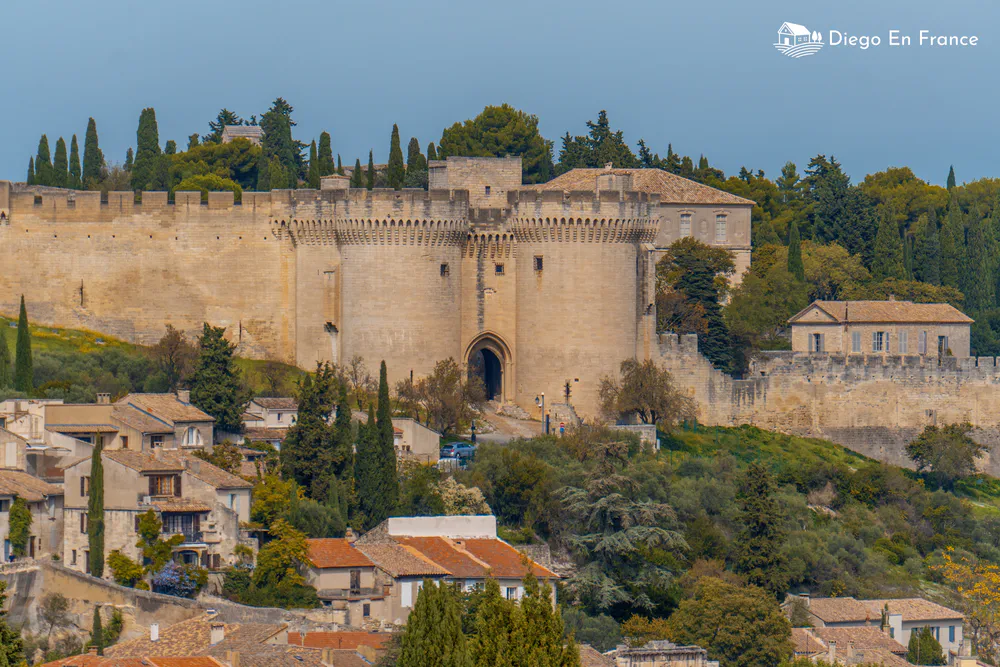
On the banks of the Rhône, just across from lively Avignon, lies Villeneuve-lès-Avignon, a little village that truly surprised us when we first discovered it. Small, serene, and quietly elegant, it wins you over without even trying.
You discover it slowly, wandering through shaded little streets and bougainvillea-covered façades, until suddenly, and almost unexpectedly, you find the Chartreuse du Val de Bénédiction, the majestic Fort Saint-André, or the lovely Château Gardens, with their sweeping views over all of Provence.
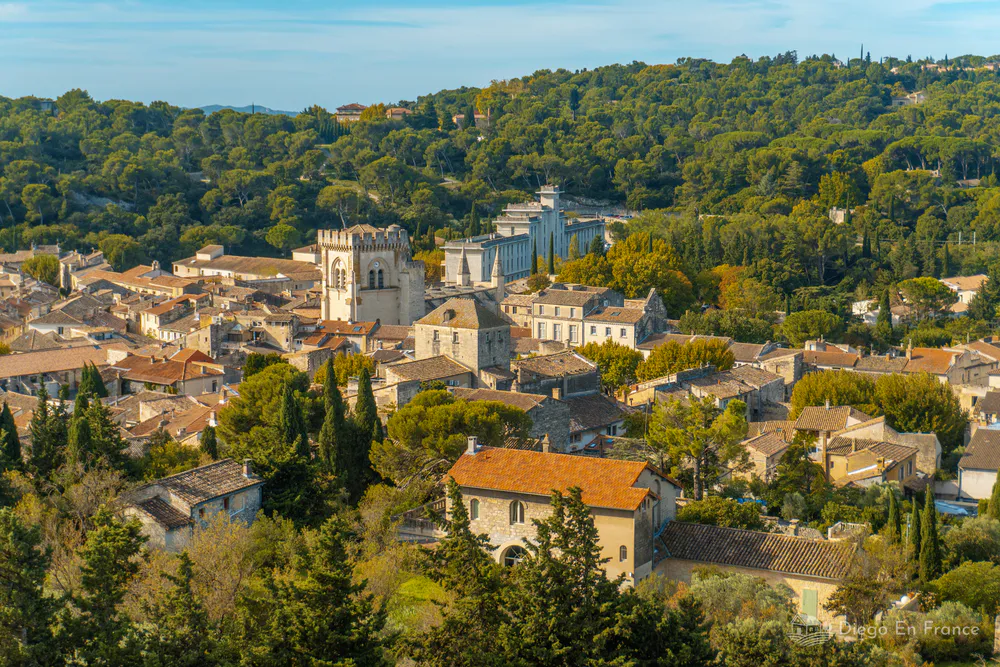
Everything here carries the calm of another era, yet with the monumental grandeur of a historic capital.
And that’s exactly what I love about Villeneuve-lès-Avignon — its perfect balance between silence and splendor, between history and everyday life.
A perfect place to experience France with all five senses — without crowds, with time to look, listen, and breathe.
The Map of Villeneuve-lès-Avignon
Before you start exploring its streets and monuments, here’s the map of Villeneuve-lès-Avignon, in Provence, France, to help you easily locate the main sights to see. Perfect for planning your visit and making the most of your day.
Villeneuve-lès-Avignon is ideal to visit together with Avignon, as the two are only separated by the Rhône River.
👉 Read the most complete travel guide to Avignon
What to see in Villeneuve-lès-Avignon
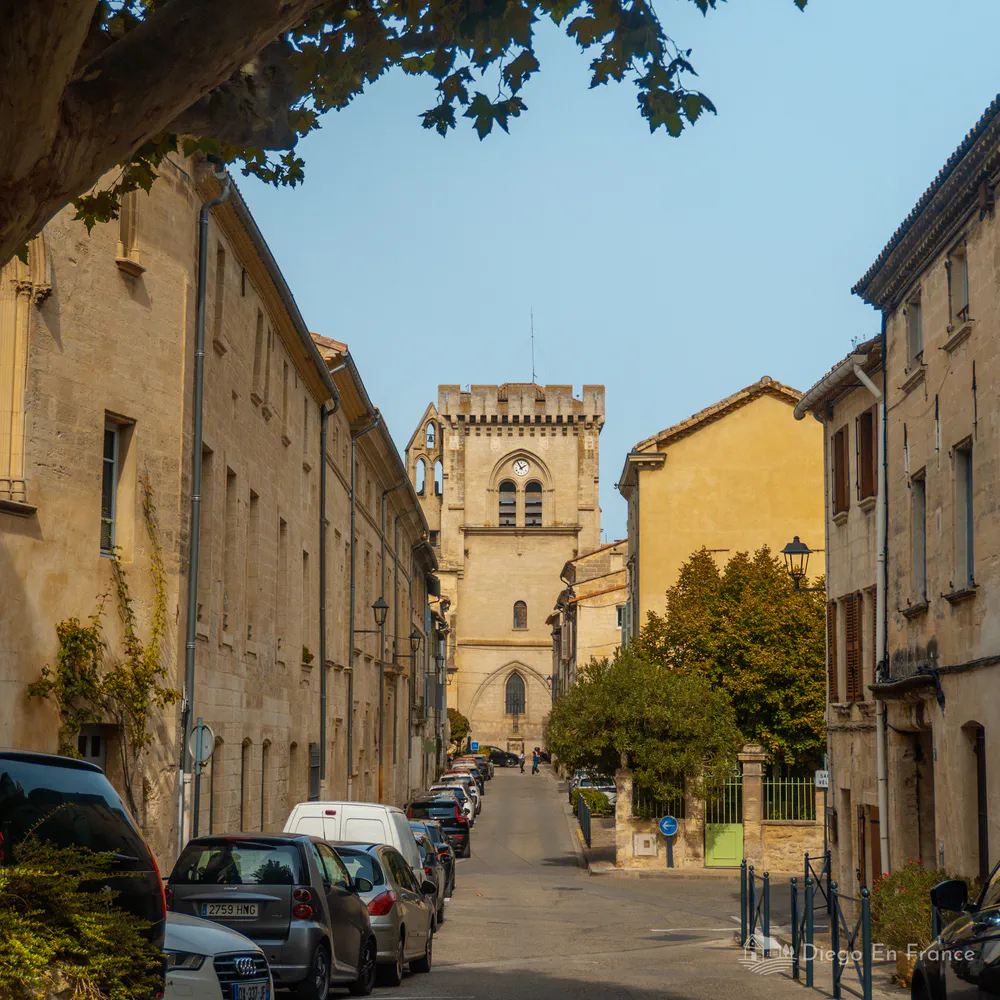
Despite its small size, Villeneuve-lès-Avignon is home to some of the most remarkable monuments in southern France.
Every corner holds a surprise, as if the village had kept its splendor just for those who dare to cross the river from Avignon.
👉 Are you planning to come here? Don’t miss the most complete guide with genuine travel tips for visiting France, written by a local..
The heart of Villeneuve-lès-Avignon: squares, terraces, and Provençal life
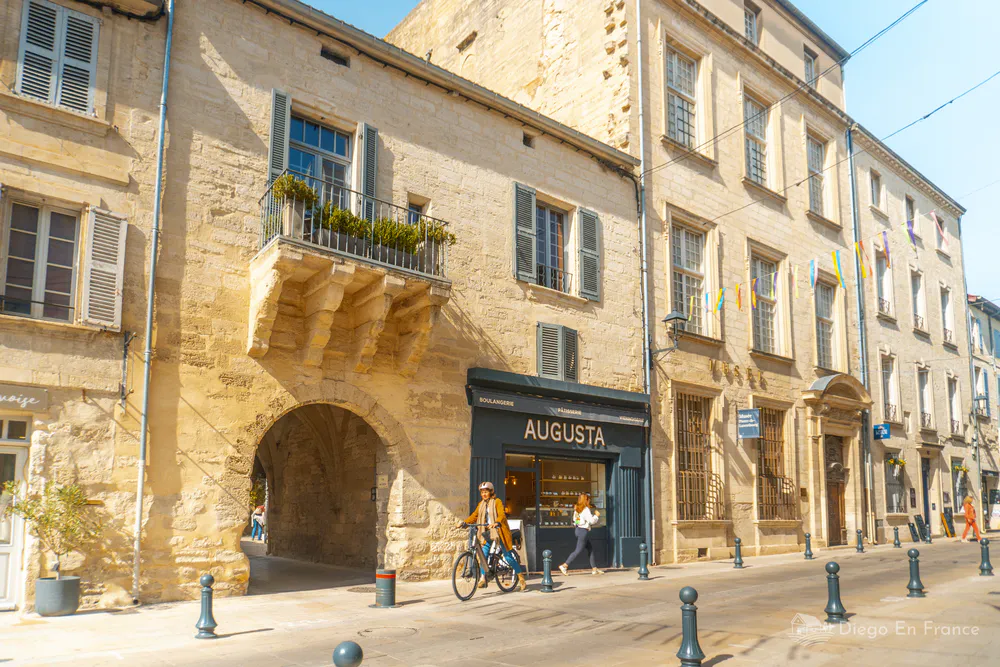
The first thing I recommend is to stroll through the center of Villeneuve-lès-Avignon. It’s one of those experiences that make you fall in love with the South of France.
The pace is slow, and the streets are narrow yet elegant. Around Place Jean Jaurès, the heart of the village, you’ll find the most inviting terraces to sit down and enjoy a drink under the shade of the plane trees.
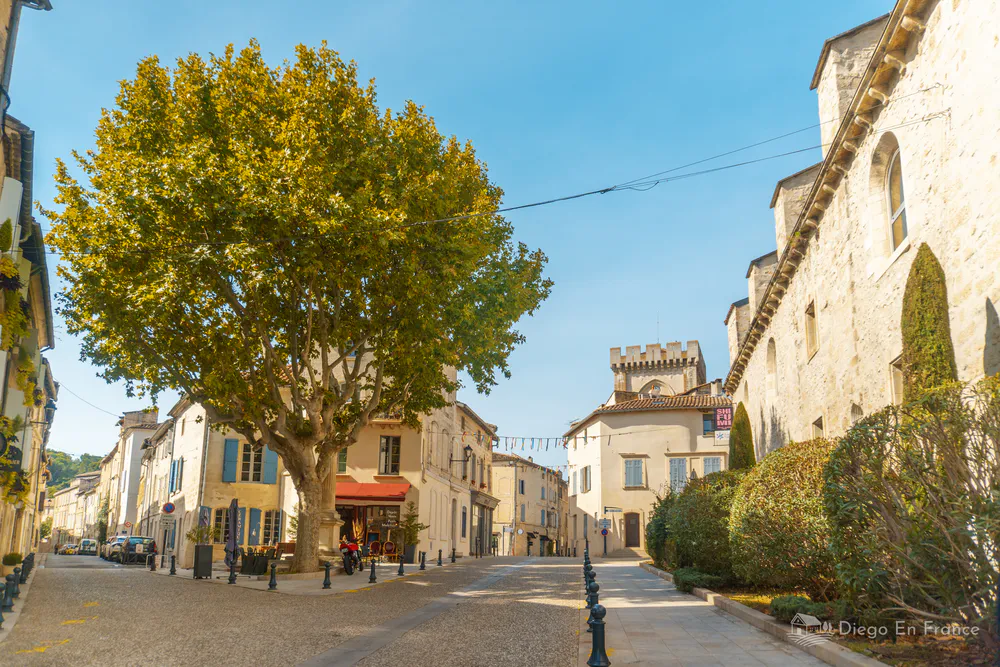
Travelers who love authentic experiences will enjoy watching the locals go about their daily lives, chatting with producers, or discovering charming shops filled with décor, art, and antiques.
Villeneuve-lès-Avignon has that simple, natural elegance that only villages with a true soul can preserve.
Visit l’Église Collégiale Notre-Dame
Just a few steps from the main square stands the Église Collégiale Notre-Dame, a magnificent example of Provençal Gothic architecture.
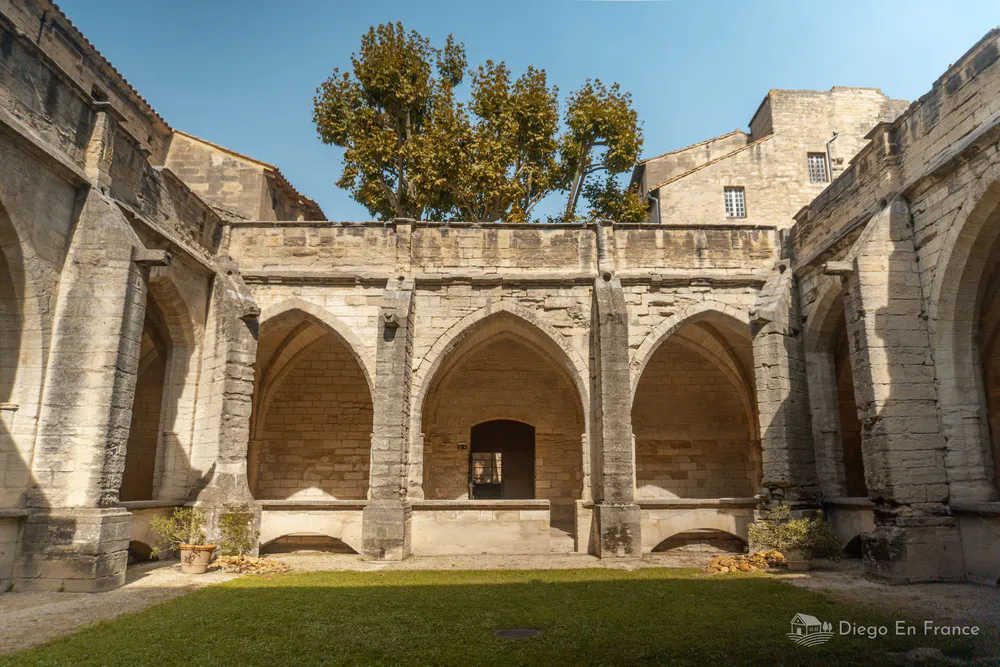
Its modest façade doesn’t reveal the beauty inside, where stained-glass windows and a monumental organ stand out.
The true treasure, however, lies in the cloister, a quiet, light-filled space that instantly brings a sense of peace.
Walking beneath its arches and hearing the sound of the bells captures the serene spirit of Villeneuve-lès-Avignon.
It’s worth spending a few minutes there, sitting for a moment, and letting time stand still.
La Chartreuse du Val de Bénédiction, a must-see in southern France
✅ Chosen by diegoenfrance.com for its monumental beauty and exceptional state of preservation.
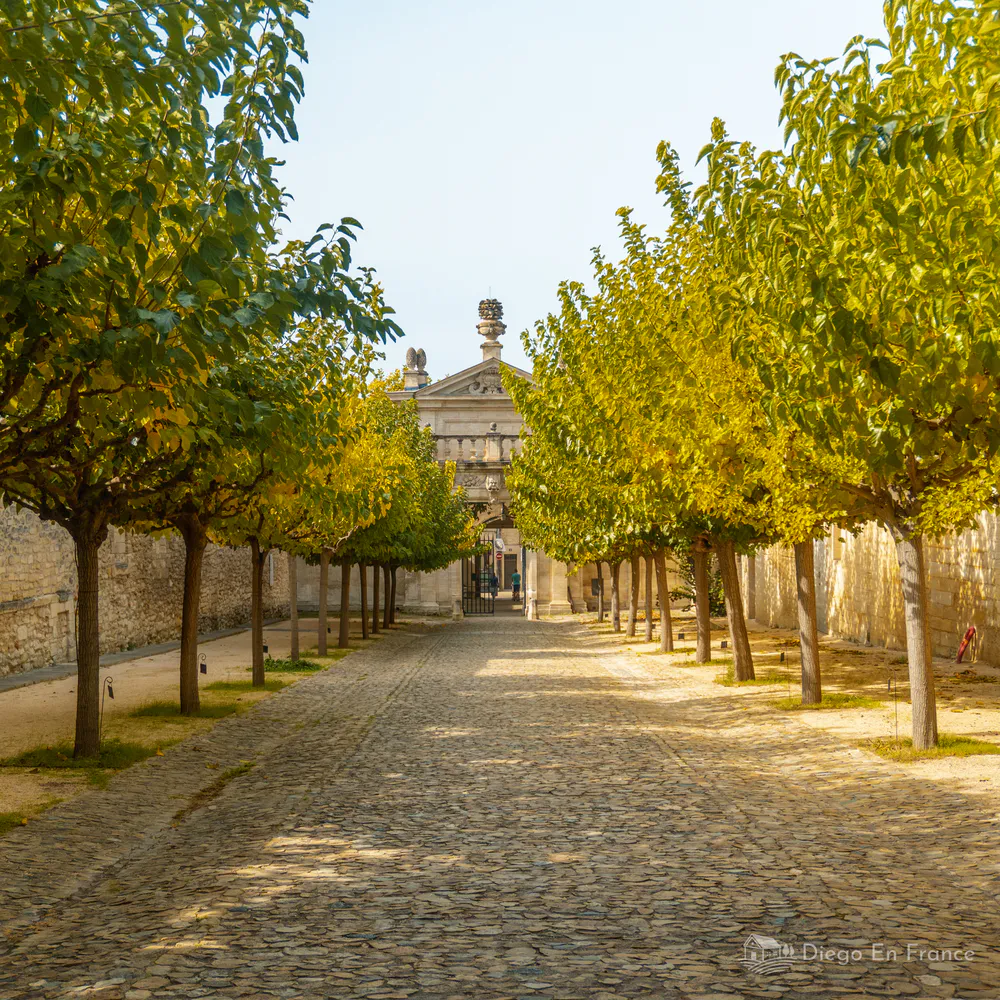
At first glance, no one would imagine that such a small village could hide a monumental complex of this scale.
Its discreet entrance barely hints at the true magnificence of this ancient site.
The Chartreuse du Val de Bénédiction, founded in the 14th century, covers a vast area and yet preserves an almost monastic serenity.
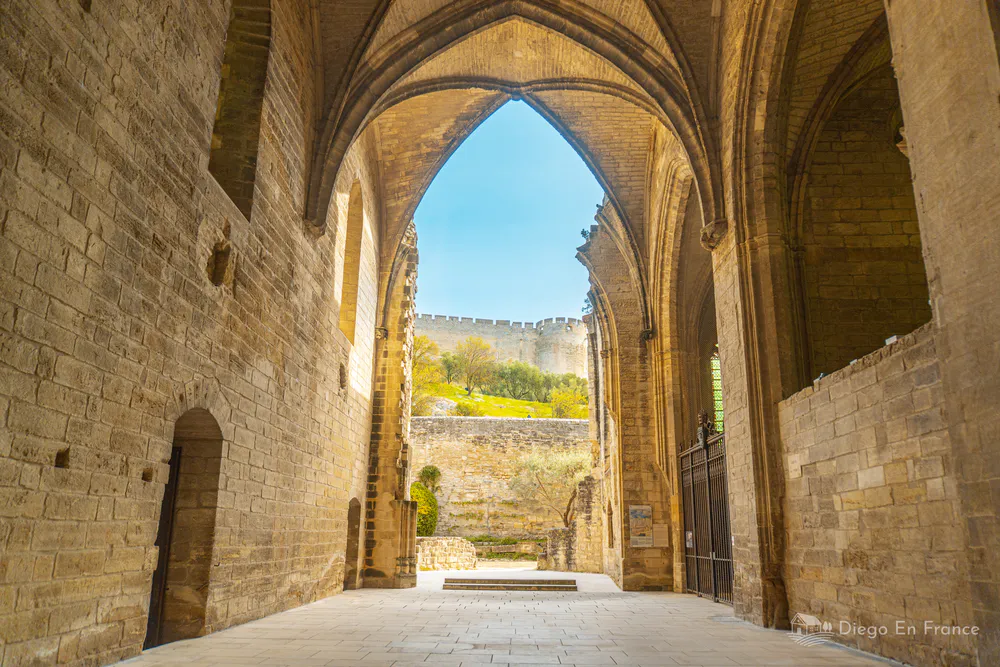
Its courtyards and cloisters follow one another, with walls draped in ivy, pale stone columns, and a soft light filtering through the arches.
The visit is very complete, taking you through the former living quarters of the monks, their individual cells with small inner gardens, and the large cloisters connecting each section.
Everything is presented in an engaging and accessible way, with models, signs, and projections that help you imagine what daily life was like inside the monastery.
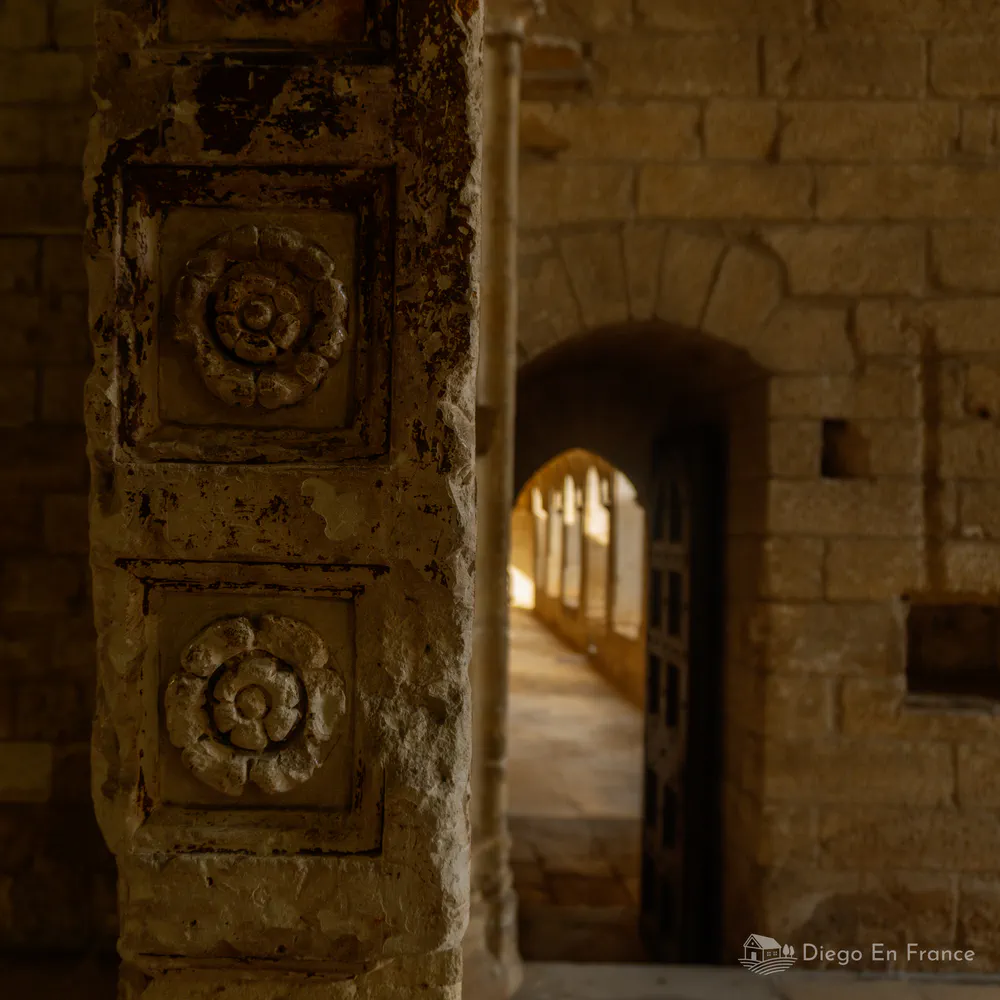
It’s a place that invites you to slow down, walk quietly, and listen to the echo of your own footsteps. Within these walls, you can still feel the spirit of the Carthusian monks who lived here for centuries.
❤️ What I loved most: its unexpected grandeur. Behind a modest entrance lies a monumental complex that leaves you speechless.
⌚ Opening hours (October 2025): Wednesday to Monday from 9:30 am to 6:30 pm (April to October); from 10 am to 1 pm and 2 pm to 5 pm (November to March). Closed on Mondays.
🎫 Admission: €8 adults / €6.50 reduced rate / free for visitors under 18 and people with disabilities plus one companion. ⚡ Visit included in the Avignon City Pass
The Fort Saint-André: history, views, and heritage in Villeneuve-lès-Avignon
✅ Reviewed by diegoenfrance.com as one of the most impressive medieval fortresses in southern France.
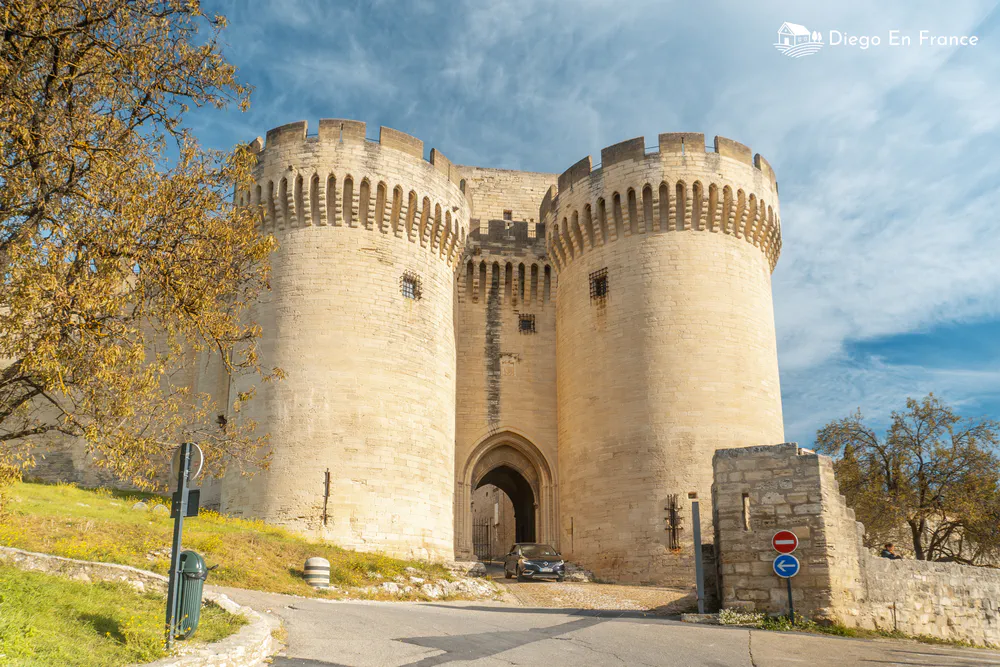
Fort Saint-André dominates the entire Rhône Valley from the top of the hill. Built in the 14th century by order of the King of France, this fortified complex had a clear goal: to assert the power of the French crown against the papal city of Avignon, located just across the river.
From its perfectly preserved towers and ramparts, the view is simply spectacular. You can see the Palais des Papes, the Pont d’Avignon, and on clear days, even the distant Mont Ventoux.
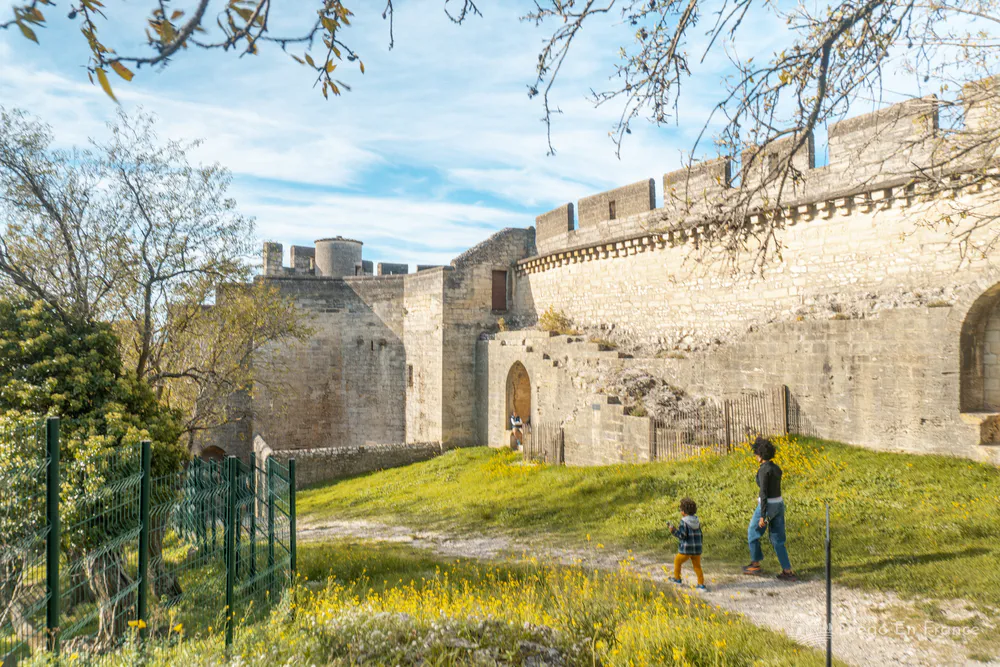
The visit is very well organized, with impeccably preserved interior spaces and clear explanations about each section, including reconstructions of war machines and armor that illustrate military life in the Middle Ages.
The tour is self-guided and allows you to pause at marked viewpoints to understand the fort’s strategic importance during medieval times.
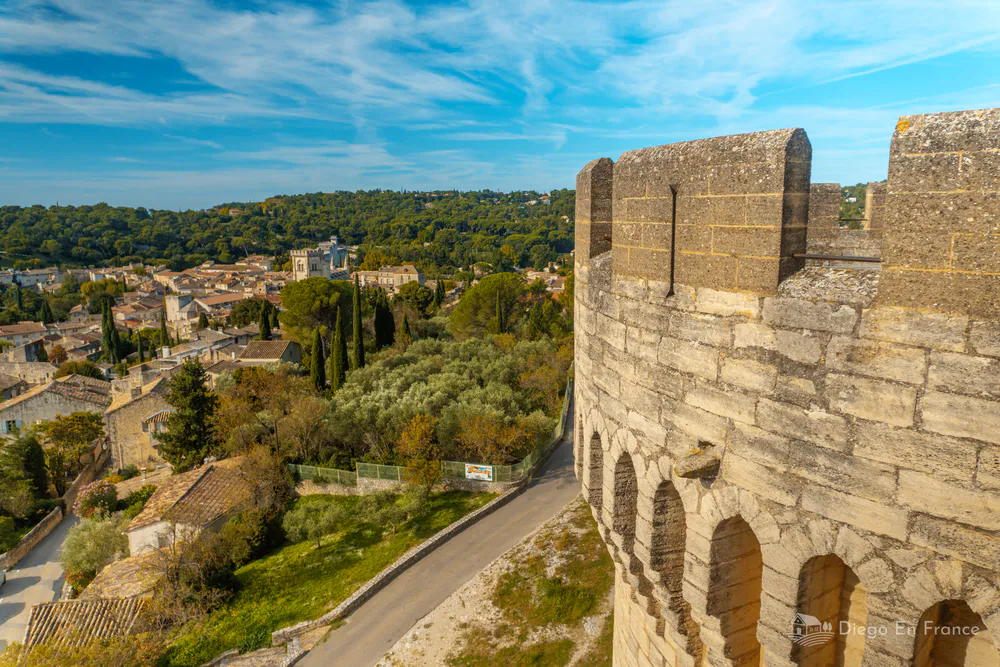
In addition, the fort has served as a filming location for several movie productions, adding a special charm to the experience.
It’s an ideal visit for those who love heritage tourism, photography, and wide-open views of southern France.
❤️ What I loved most: exploring the fort’s old rooms and towers, where the defensive details are still visible. Every corner tells a story.
👉 Diego’s tip: wear comfortable shoes for climbing narrow stairs and walking along stone or dirt paths. In summer, remember sun protection and a hat.
⌚ Opening hours (October 2025): open daily from 10 am to 1 pm and from 2 pm to 6 pm (June to September) and until 5 pm (October to May).
🎫 Admission: €7 adults / free for visitors under 18 and people with disabilities plus one companion. ⚡ Visit included in the Avignon City Pass
😉 For the kids: it’s a super fun visit with passageways, hidden rooms, and paths that invite exploration and play.
The Gardens of the Abbey Saint-André: the most beautiful corner of Villeneuve-lès-Avignon
✅ Featured on diegoenfrance.com as one of the most beautiful and surprising gardens in France.
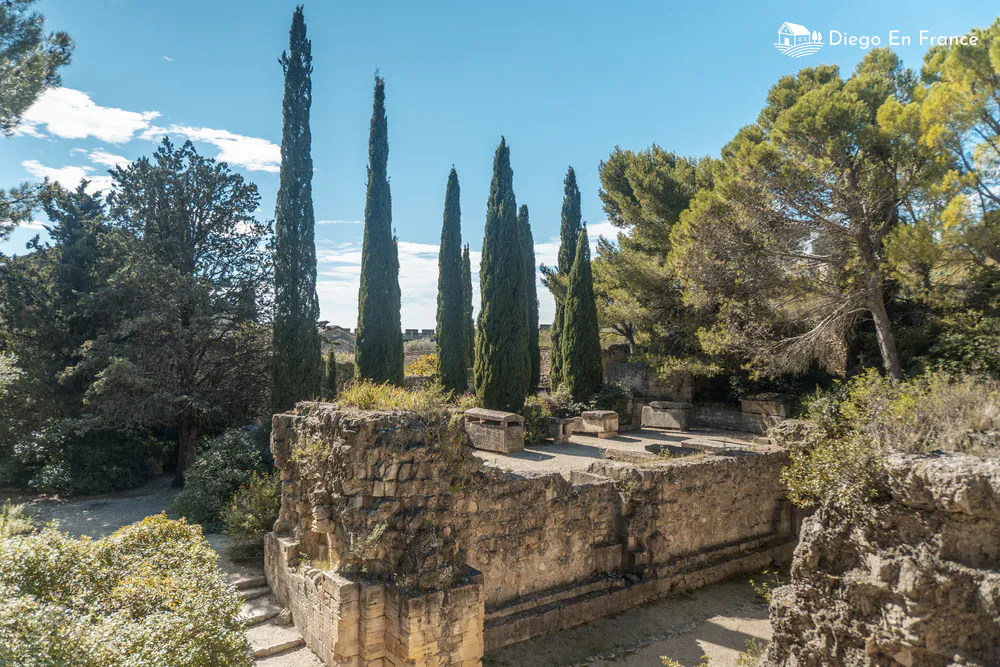
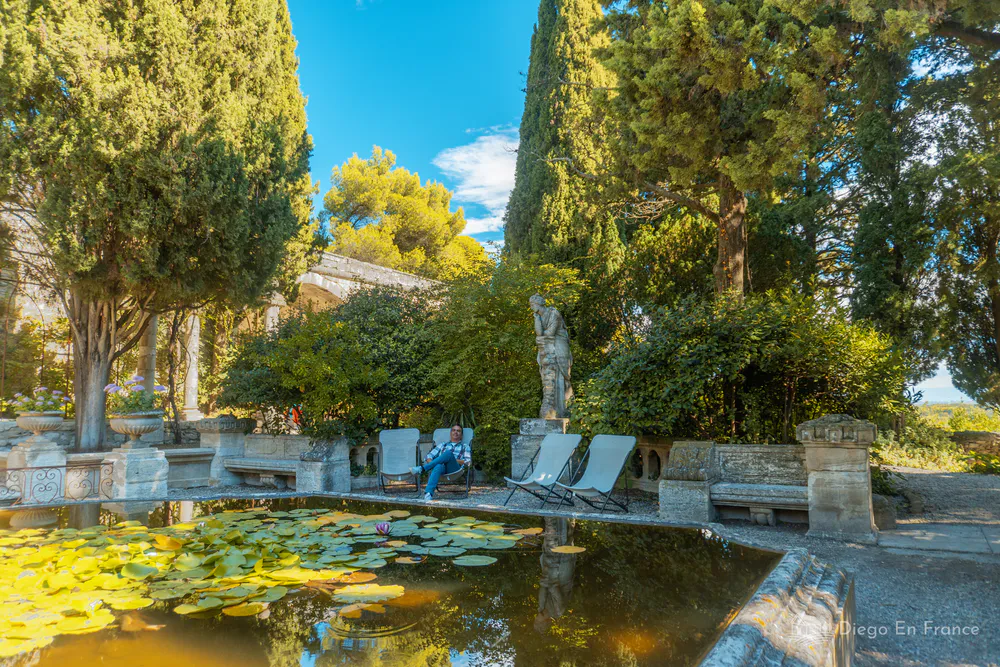
Our walk through the Gardens of the Abbey Saint-André was one of those experiences that will stay with me forever.
We didn’t expect to find something so majestic within such a peaceful setting. It’s a garden that surprises with its perfect balance between nature and architecture, with terraces gently descending toward the valley, open views of Avignon and Mont Ventoux, and corners that even recall the gardens of Tuscany.
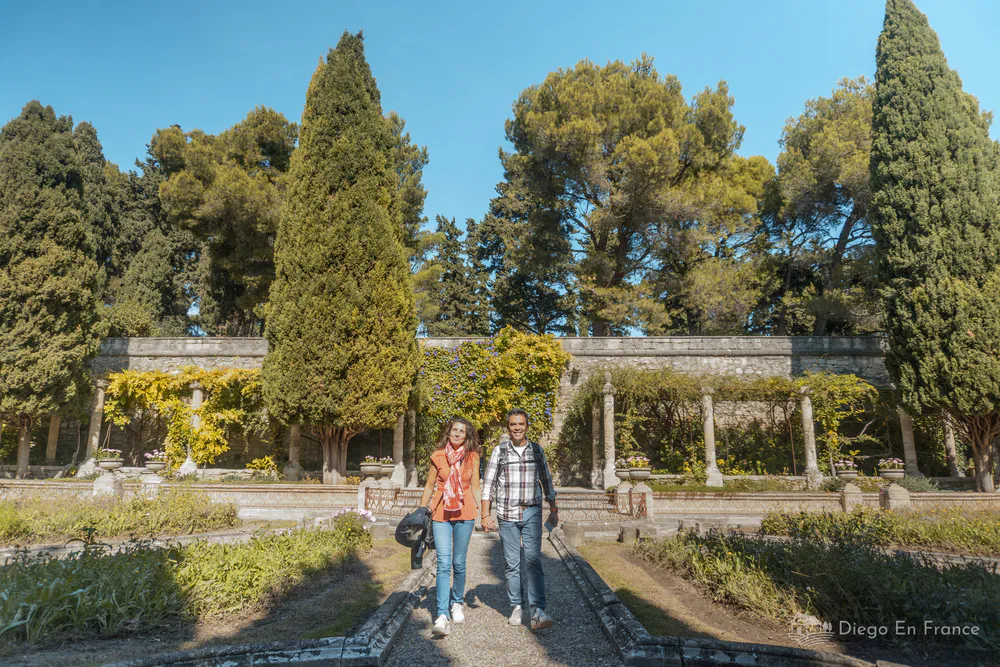
The paths wind among cypresses, olive trees, rose bushes, and all kinds of vegetation and flowers, with ponds where water lilies float and stone benches or lounge chairs inviting you to pause for a while.
The visit is best enjoyed slowly, letting yourself be carried away by the scents, the sounds, and the views that shift with the light.
To this day, I can say without hesitation: it’s the most beautiful garden I’ve ever visited.
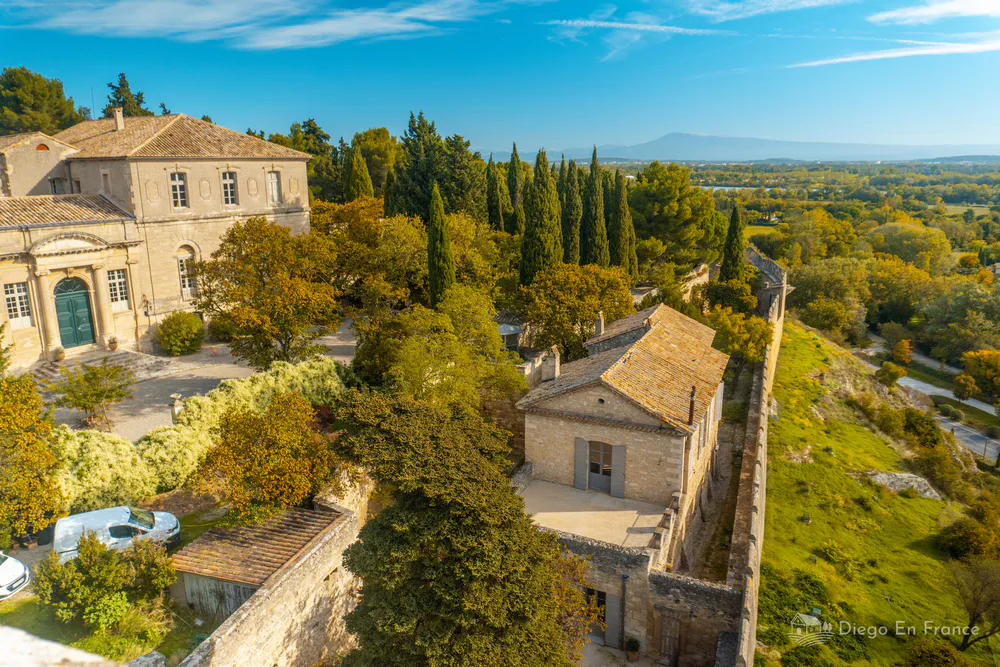
❤️ What we loved most: its absolute serenity and those views that look like a painting. Everything is cared for with exquisite taste, without excess, in a perfect balance between history and nature.
👉 Diego’s tip: picnics are not allowed inside the grounds, so I recommend visiting after lunch or planning a break in the village before or after your visit. Bring water, sun protection, and comfortable shoes, as there are slopes and stone paths.
⌚ Opening hours (October 2025): open daily from 10 am to 5 pm (November to February) and from 9:30 am to 6:30 pm (March to October). Last entry 30 minutes before closing.
🎫 Admission: €9 adults / €7.50 reduced rate / free for children under 8. ⚡ Visit included in the Avignon City Pass
😉 For the kids: there are winding paths that go up and down, small woods, and ponds — a perfect walk to awaken children’s senses.
The Tour Philippe-le-Bel: the historic gateway to Villeneuve-lès-Avignon
✅ Recommended by diegoenfrance.com for its unique views over the Rhône and the Palais des Papes.
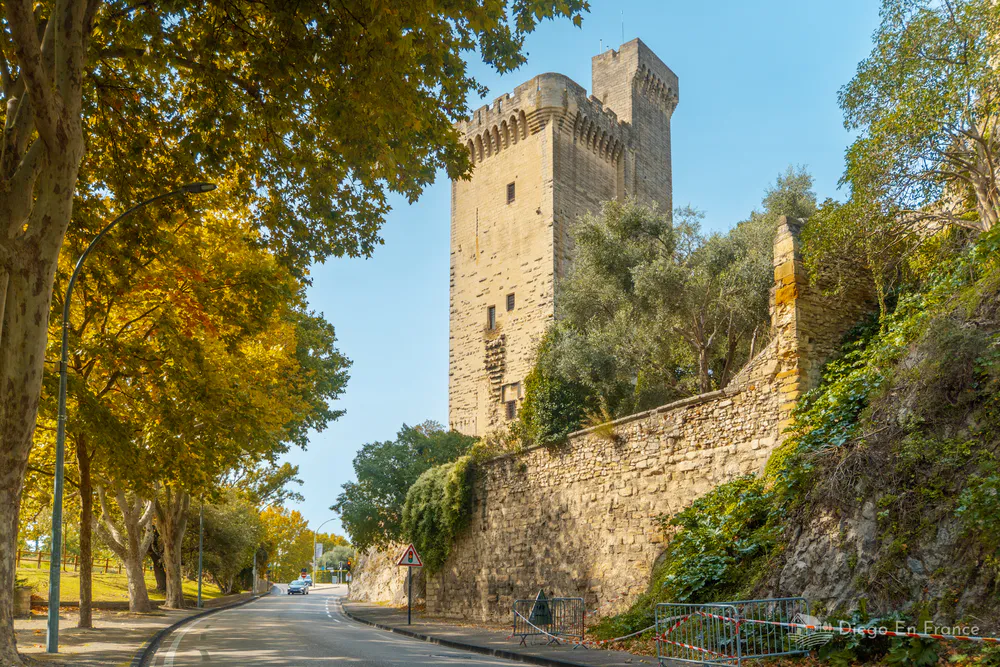
At the entrance of the village stands the Tour Philippe-le-Bel, an imposing tower that once marked the border between the Kingdom of France and the papal territory of Avignon.
It was built at the end of the 13th century by order of King Philip the Fair (Philippe-le-Bel), and its purpose was to control access to the famous Pont d’Avignon.
Today, its silhouette still watches over the river, just as it did more than seven hundred years ago.
The visit is short but very interesting. You can explore the different floors, where explanatory panels and audiovisual displays tell the story of the tower, the bridge, and the relationship between both territories..
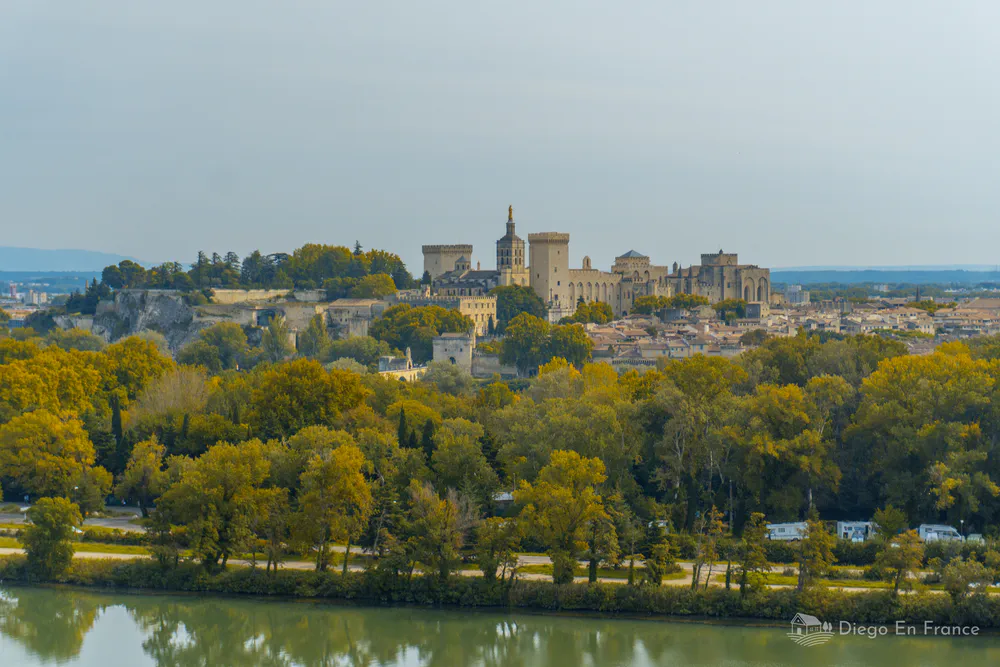
The climb ends at a terrace that offers magnificent views of the Rhône, the Palais des Papes, and the whole of Avignon.
Climbing to the top is absolutely worth it, the view is among the most beautiful in southern France. And don’t worry, it’s only 124 steps.
❤️ What I loved most: the view from the upper terrace, with the Rhône at your feet and Avignon right in front of you. A panorama that captures centuries of history in a single glance.
⌚ Opening hours (October 2025): open daily from 10 am to 5 pm (November to February) and from 9:30 am to 6:30 pm (March to October). Confirm with the Avignon Tourist Office.
🎫 Admission: €4.50 adults / €3.50 reduced rate / free for visitors under 18. ⚡ Visit included in the Avignon City Pass
😉 For the kids: they love climbing the spiral staircase and peeking through the tower’s small windows. It’s a short, fun visit with a panoramic reward at the end.
The Musée Pierre-de-Luxembourg: art and tranquility in the heart of Villeneuve-lès-Avignon
✅ Recommended by diegoenfrance.com for its exceptional collection of medieval and religious art.
On a quiet street in the center lies the Musée Pierre-de-Luxembourg, a small museum that houses true treasures of medieval and religious art.
It occupies a former 14th-century mansion that once belonged to the family of Cardinal Pierre de Luxembourg and still preserves the sober, elegant atmosphere of that era.
The visit is short, but every room holds a surprise. Among its highlights is the famous Pietà of Villeneuve-lès-Avignon, attributed to Enguerrand Quarton, a painting that moves you with its delicacy and color.
You’ll also find Gothic sculptures, tapestries, liturgical objects, and artifacts that reveal everyday life in the convents and abbeys of the region.
The museum is small, peaceful, and rarely crowded, allowing you to enjoy art in silence, without rush, with time to observe every detail.
Perfect for those who enjoy cultural tourism and intimate museums filled with history and soul.
❤️ What you’ll love: discovering such a small museum with such precious works. It’s a haven of calm and beauty right in the heart of the village.
👉 Diego’s tip: combine it with a visit to the Chartreuse; they’re just a few minutes apart on foot and together offer a complete glimpse into the region’s art and spirituality.
⌚ Opening hours (October 2025): open Wednesday to Monday, from 10 am to 12:30 pm and 2 pm to 6 pm. Closed on Tuesdays.
🎫 Admission: €4.50 adults / €3.50 reduced rate / free for visitors under 18 and for people with disabilities plus one companion.
Taste One of France’s Most Famous Wines
✅ Selected by diegoenfrance.com as one of the best wine experiences from Avignon.

Spend a day among vineyards, historic wineries, and Provençal landscapes on this full-day tour from Avignon. You’ll taste the celebrated wines of Châteauneuf-du-Pape, Gigondas, and Vacqueyras, visit charming medieval villages, and enjoy a two-course gourmet lunch in a unique setting.
✔️ A perfect experience for couples and wine lovers, personally recommended by diegoenfrance.com for its authenticity and smooth organization.
👉 From €160 per person
👉 Discover more things to do nearby with my guide to 30 amazing ideas for enjoying Provence with your family.
Save Time with the Avignon City Pass
✅ Featured on diegoenfrance.com as the best way to access the main monuments without lines or hassle.
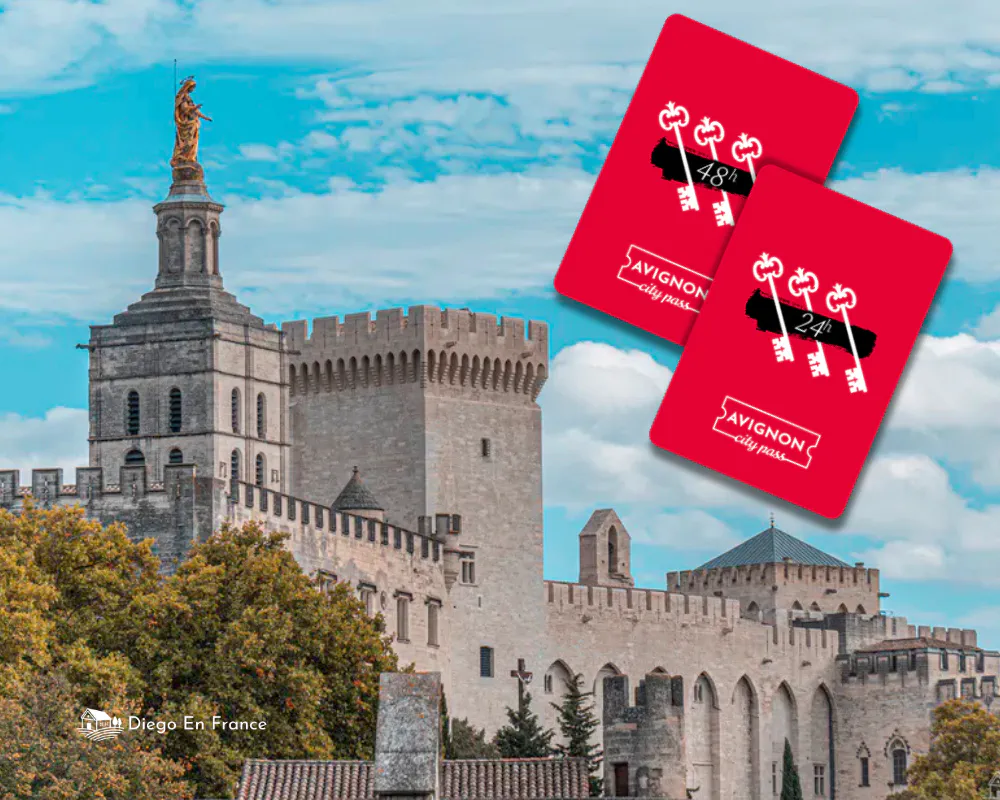
The Avignon City Pass makes visiting the city wonderfully easy.
We used it during our last visit here, and I can assure you it’s fantastic. With this pass, we were able to explore Avignon and Villeneuve-lès-Avignon with incredible ease.
We entered and left monuments and museums as effortlessly as you walk in and out of a bakery.
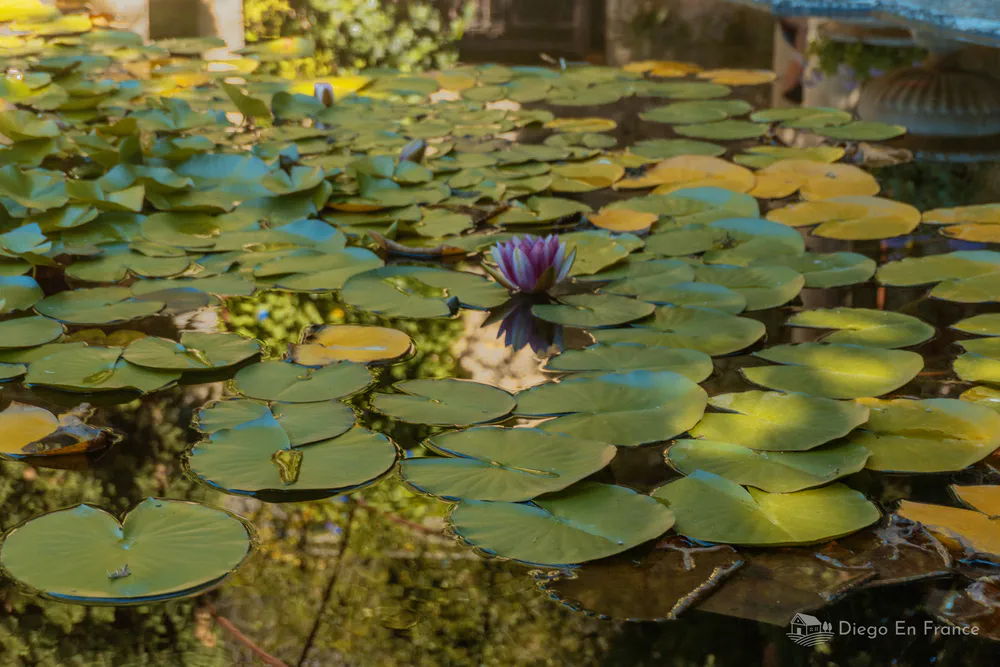
In addition to the main sights in Avignon, it includes entry to La Chartreuse du Val de Bénédiction, Fort Saint-André, the Gardens of the Abbey Saint-André, the Tour Philippe-le-Bel, and many other cultural sites — all without waiting in line or worrying about buying separate tickets.
🎫 Prices (2025):
- 24 € for 24 hours
- 32 for 48 hours
You can buy it online at the Avignon tourist office or directly at the ticket office of the Palais des Papes. It is activated with your first visit and is valid for consecutive hours, depending on the type of pass chosen.
🕓 Validity: consecutive days (24, 48 hours).
💡 Local tip: it’s perfect for travelers who enjoy a relaxed pace. You can explore at your own rhythm, take a break for lunch, and then effortlessly enter another site within the old town.
👉 Visiting soon? Then you should read my guide to the best local shops and places to enjoy during your trip to France.
Practical information for visiting Villeneuve-lès-Avignon
How to get to Villeneuve-lès-Avignon
Villeneuve-lès-Avignon is located just across from Avignon, separated only by the Rhône River. From the center of Avignon, you can reach it by car in less than 10 minutes by crossing the Pont Daladier or the Pont de l’Europe.
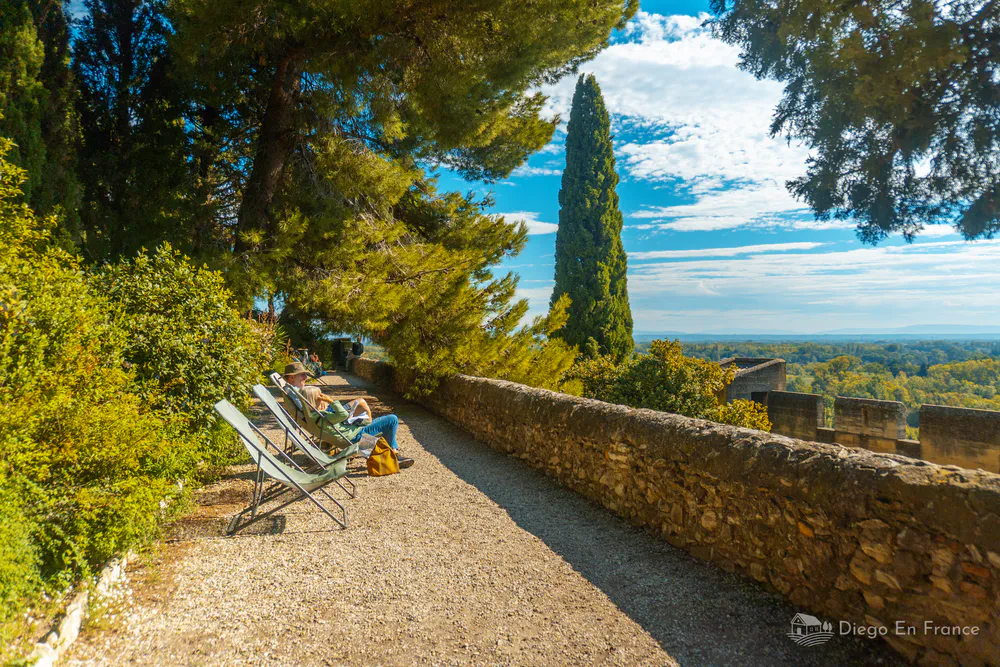
There are also bus lines connecting both places several times a day (line 5 of the Orizo network).
If you’re coming from other cities in southern France, access via the A9 motorway is direct and well signposted.
Where to park
The village has several free and paid parking areas near the historic center.
The most convenient option, without having to drive into the village itself — and where we parked — is the Parking Charles de Gaulle. From there, you can easily walk everywhere.
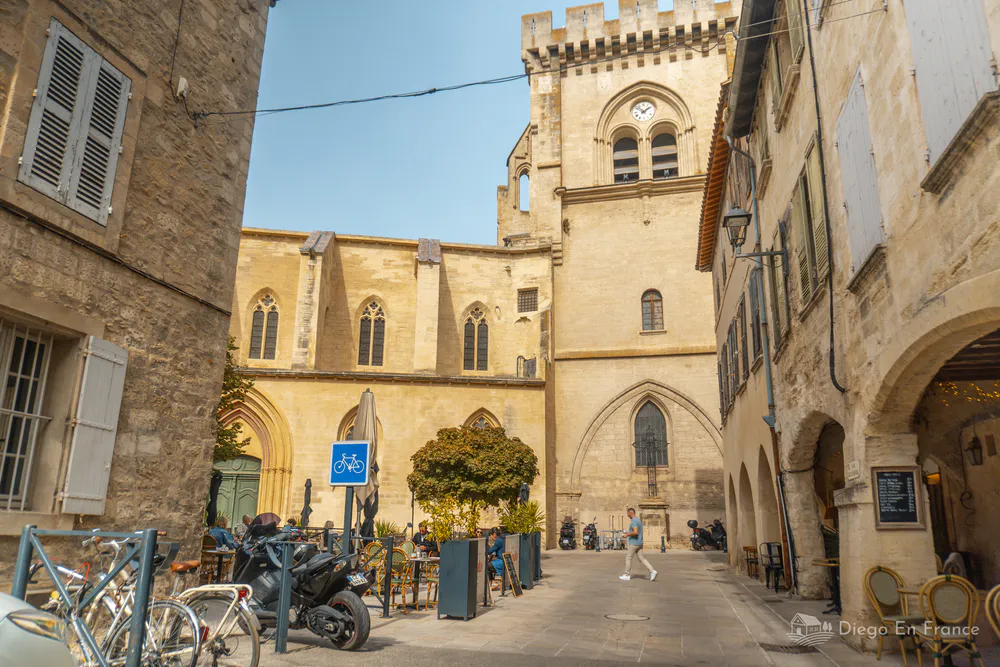
There is also a large parking lot next to the entrance of Fort Saint-André, perfect if you plan to visit the gardens or continue walking toward the old town.
Distances are short, and everything can easily be explored on foot.
Parking Charles de Gaulle
Free parking
🧭 Coordinates: 43.96393253063496, 4.801370647387948
Plus Code: XR72+G5 Villeneuve-lès-Avignon
👉 If you’re traveling by car, don’t miss the most complete guide with genuine tips for driving in France, written by an experienced local traveler..
How much time to spend in Villeneuve-lès-Avignon
Ideally, plan for half a day or a full day to enjoy the village at a relaxed pace.
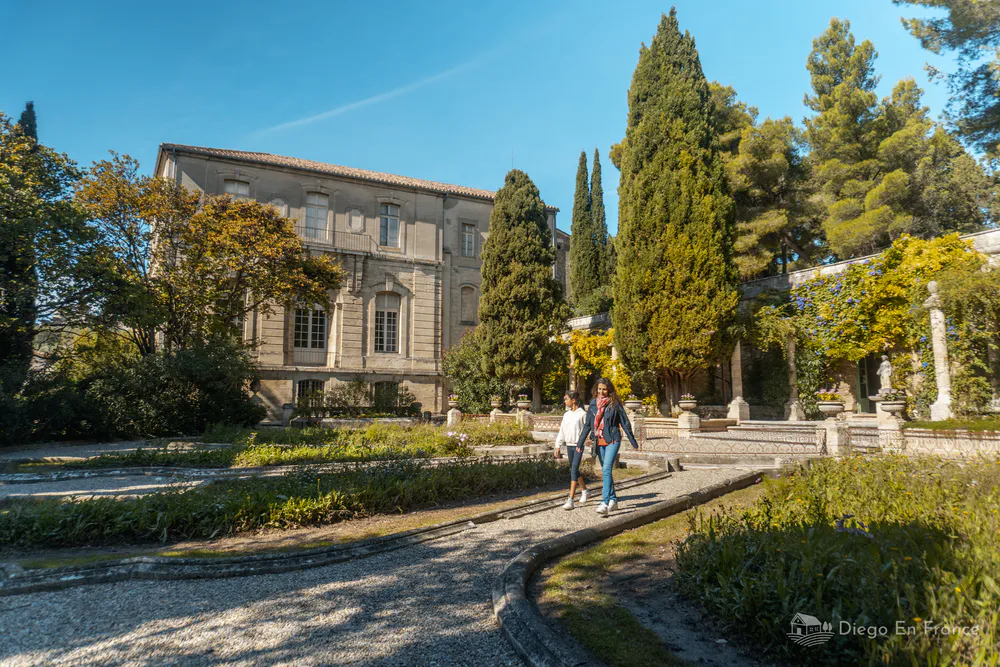
If you also want to visit the Chartreuse, the Fort, the Gardens, the Tower, and the Museum at a relaxed pace, you’ll need at least a day and a half.
Best time to visit
Villeneuve-lès-Avignon is charming all year round, but spring and autumn offer the most pleasant weather for walking and enjoying the gardens.
In summer, temperatures can get quite high, so it’s best to visit early in the morning or later in the day.
Where to eat in Villeneuve-lès-Avignon
Villeneuve-lès-Avignon has a small but excellent selection of restaurants.
If you’re looking for a special experience, the restaurant Le Prieuré is an absolute must. Located in a former monastery converted into a hotel, this elegant Michelin-starred restaurant combines Provençal tradition with refined, contemporary cuisine.
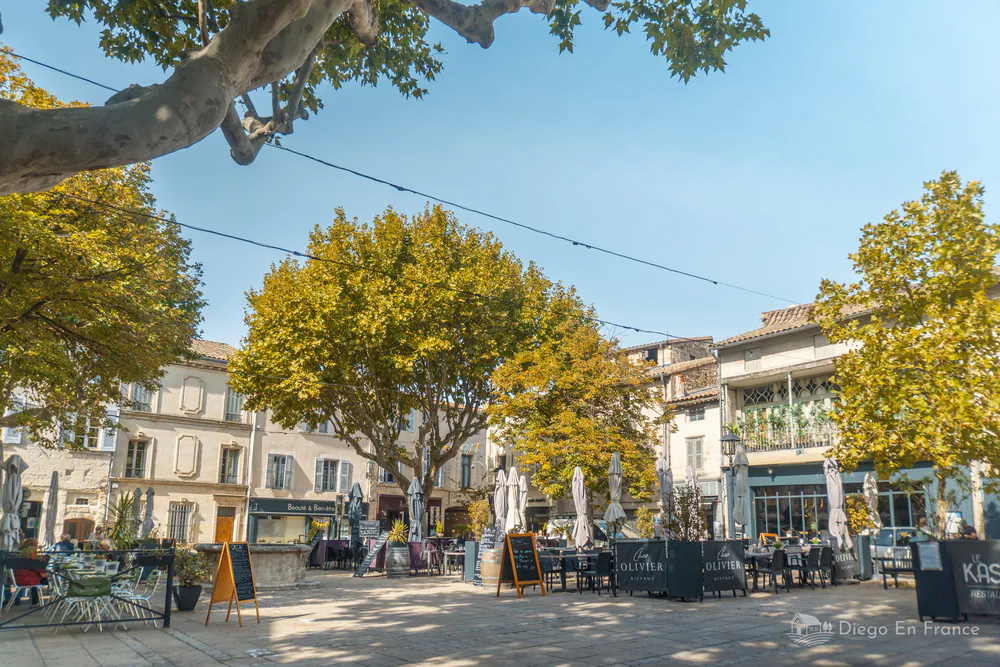
The setting is delightful: tables shaded by plane trees, impeccable tableware, and service that reflects the calm elegance of the place.
Perfect for ending your visit with an unforgettable meal.
📍 Address : 7 Pl. du Chapitre, 30400 Villeneuve-lès-Avignon
If you prefer something more casual, in the elegant Place Jean Jaurès and its surroundings you’ll find several charming, comfortable terraces where you can enjoy a daily menu, regional dishes, cheeses from the Gard, and wines from the Rhône Valley.
A slow lunch with a glass of wine, watching the gentle rhythm of the village, has its own kind of magic.
👉 Diego’s tip: if you plan to dine at Le Prieuré, book in advance. During high season, tables fill up quickly.
👉 Read the most complete guide with genuine tips for dining in restaurants across France.
Where to stay in Villeneuve-lès-Avignon
Spending a night in Villeneuve-lès-Avignon completely transforms the experience. When evening falls and visitors leave, the village regains its calm, the streets grow quiet, and the air fills with the soft sounds of southern France.
There are options for every taste: from charming chambres d’hôtes run by their owners and lovingly decorated, to small boutique hotels set in old stone houses with inner courtyards and pools.
There are also a few rural houses and vacation apartments, perfect for families who prefer more independence.
Hôtel Château de l’Insolas ⭐⭐⭐⭐⭐
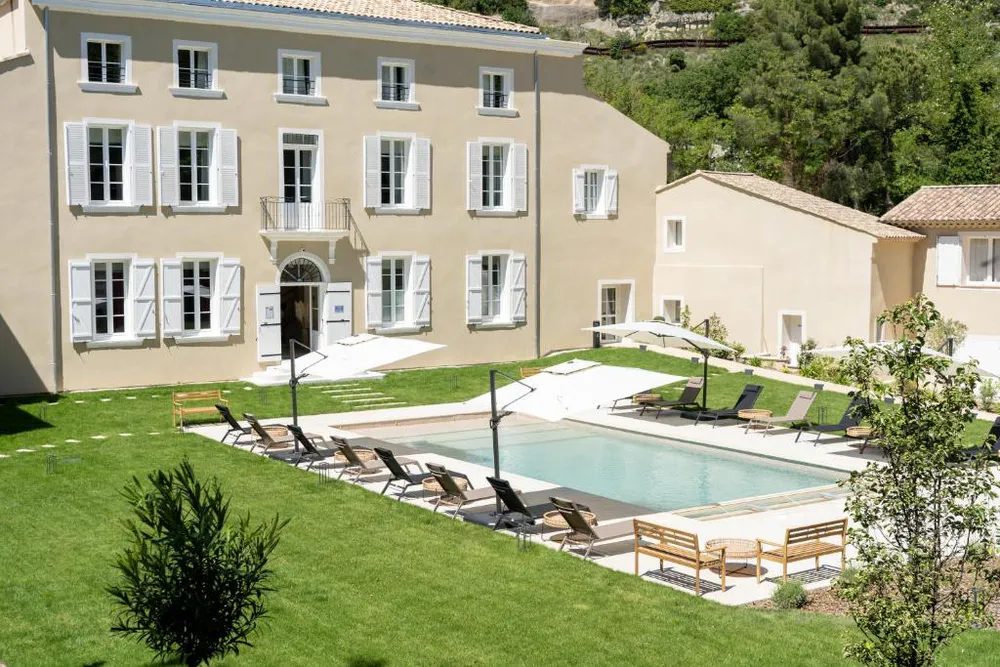
If you’re looking for something truly special, I recommend the Hôtel Château de l’Insolas, a five-star hotel located just outside the village.
Its setting is spectacular: a castle surrounded by vineyards and olive groves, with open views of the Provençal countryside.
The rooms blend classic elegance with modern touches, and the restaurant serves top-quality local cuisine.
A perfect place for those who want to experience the South of France with calm, understated luxury, and authenticity.
📍 Address: 1 Château de L’Insolas ou des Lions, 30400 Villeneuve-lès-Avignon
👉 Rooms from €160 per night
Nearby villages to visit
✅ Villages visited and featured on diegoenfrance.com for their heritage value, gastronomy, and Provençal charm.
From Villeneuve-lès-Avignon, you can easily explore other charming villages in the south of France.
All are very close and preserve that same Provençal spirit, surrounded by vineyards, rolling hills, and small squares where time seems to stand still.
Villeneuve-lès-Avignon, a well-kept secret in the south of France
Visiting Villeneuve-lès-Avignon means discovering another side of Provence. A small, elegant village filled with history, art, and breathtaking views.
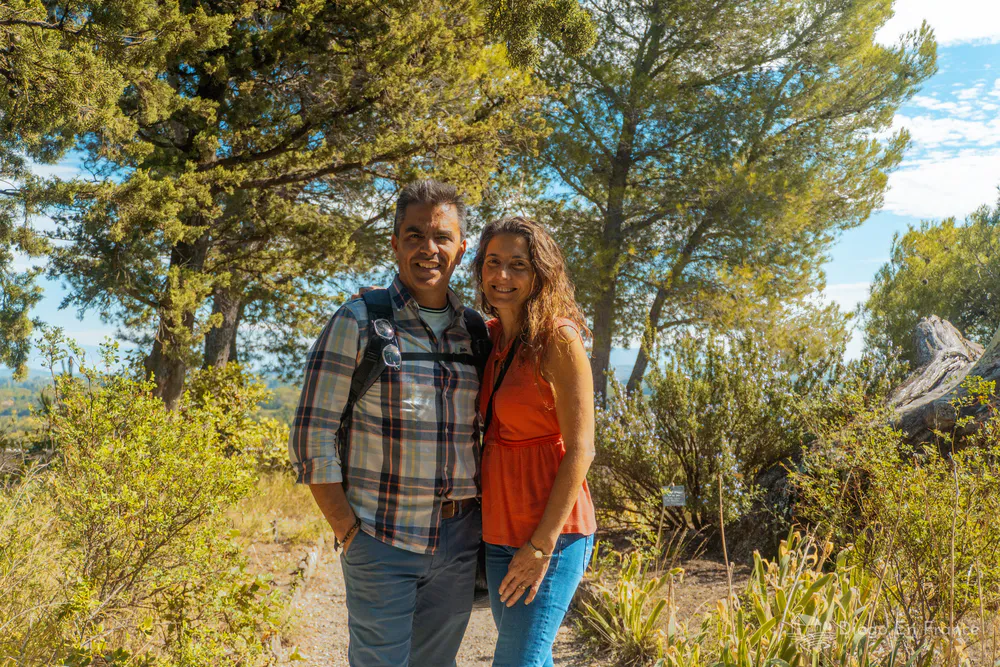
Every corner holds a piece of the past: the quiet spirituality of the Chartreuse, the strength of Fort Saint-André’s walls, the colors of the gardens, and the serenity of its streets.
It’s an ideal destination for those seeking authentic travel, away from the crowds yet close to everything.
Perfect to explore as a couple, with friends, or as a family, combining culture, nature, and great food.
Villeneuve-lès-Avignon captures the very best of southern France: sunshine, calm, elegance, and that unique art de vivre found only here.
And when you cross the bridge back to Avignon, you’ll realize something — you’ve discovered a place that isn’t just visited, it’s felt.
A brief history of Villeneuve-lès-Avignon
The history of Villeneuve-lès-Avignon is closely linked to that of its neighbor, Avignon.
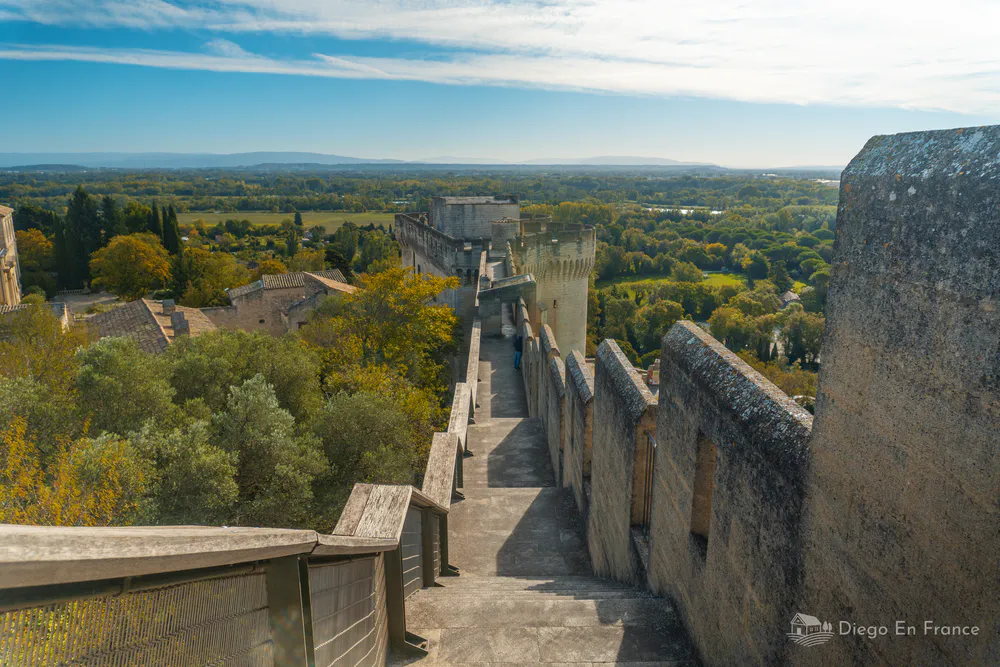
At the beginning of the 14th century, while the Papacy settled on the opposite side of the Rhône, the King of France decided to strengthen his position by building a fortified city facing it.
That’s how Villeneuve-lès-Avignon was born — the “new town beside Avignon” — which soon became home to cardinals, nobles, and influential figures.
Over the following centuries, the village flourished around its great monuments: the Chartreuse du Val de Bénédiction, Fort Saint-André, and the Collégiale Notre-Dame.
Unlike other walled cities, Villeneuve retained its human scale, its calm, and its understated elegance.
Today, walking through its streets means traveling through seven centuries of history in just a few steps.
Frequently asked questions about Villeneuve-lès-Avignon
Why is the village called Villeneuve-lès-Avignon?
The name literally means “new town beside Avignon.” It was founded in the 13th century on the opposite bank of the Rhône River, when the Kings of France sought to establish their own territory facing the papal power of Avignon. Despite its name, it has kept a deeply medieval soul and a timeless elegance.
Is Villeneuve-lès-Avignon worth visiting in France?
Yes, absolutely. It’s one of those villages that surprise you with how many monuments and how much beauty are hidden in such a small area. The Chartreuse, Fort Saint-André, the Abbey Gardens, and the Tour Philippe-le-Bel offer a perfect combination of history, art, and views. Ideal for a half-day visit or a peaceful getaway from Avignon.
How much time do you need to visit Villeneuve-lès-Avignon?
Half a day is enough to see the main sights, but if you can stay overnight, you’ll enjoy its serene atmosphere as evening falls and the streets grow quiet.
Can you visit Villeneuve-lès-Avignon with children?
Yes. It’s a very family-friendly destination: the monuments are easy to access, and there are open spaces, gardens, and educational activities at the Chartreuse and the Fort.
What is the best time to visit Villeneuve-lès-Avignon?
Spring and autumn are ideal — mild temperatures, golden light, and fewer visitors. In summer, the sun can be strong, but the terraces and gardens provide plenty of shade.
Newsletter Diego en France
Subscribe
No Spam. I send a maximum of 3 newsletters per month with the latest news about Diego in France.

Dear reader,
This article has been written by me, Diego. Who has lived in France for many years and traveled this beautiful country for many more! And is inspired by his own and his family’s experiences and tastes.
I love to spread the word about France’s charming villages and all there is to do around here and I know that many times organizing a trip can be complicated. That’s why, through my guides, I try to inspire you and help you in your planning.
I hope you have enjoyed reading this article and, above all, that it has been useful.
What do you think of my article ?


